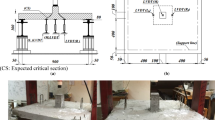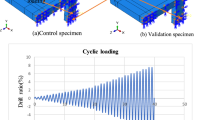Abstract
Capital is one of the common measures to strengthen the slab-column connections. It can make the joint's load capacity increase. However, when the connection is subjected to the unbalanced bending moment, the reduction effect of the capital on the bending moment is to be studied. Nonlinear finite element analysis is performed on reinforced concrete slabs with column capital for various moment-to-shear (M/V) ratios. The effect of capital radius on the punching shear resistance of slab-column connections is investigated. The 3D finite element modeling is performed using the concrete damage plasticity model and concrete constitutive equations. The concrete damage plasticity model parameters are calibrated by the experiment results of specimens. Increasing the radius of capital can improve the bearing capacity of nodes and reduce the moment transfer effect obviously.
You have full access to this open access chapter, Download chapter PDF
Similar content being viewed by others
Keywords
1 Introduction
Many experiments have been done by researchers to study slab-column connections. The disadvantage of slab-column connections is the possibility of punching shear damage in the vicinity of the column. One of the measures to enhance the joints is to provide drop panels at the head of the column. There are many different forms of drop panels, as shown in Fig. 1. However, there are few experiments on drop panels for slab-column connections in the database and almost none for different moment-to-shear ratios. Finite element analysis can be used to supplement the existing experiments after parameter calibration. The use of finite element methods allows the investigation of aspects not measured in the experiments. In this paper, the mushroom slab experiment of Lima Neto et al. [1] was selected for numerical simulation and analysis using the finite element software ABAQUS.
In practice, due to eccentric loading, the slab-column connections are subjected to both vertical loads and bending moments, as in Fig. 2, and the transmission of unbalanced bending moments reduces the punching shear resistance. The ACI-318 [2] for the moment transfer coefficient is calculated by Eq. (1).
where, \(c_{1}\) and \(c_{2}\) are the side length of the column \(d\) is the effective thickness of the slab.
Because of the great harm of unbalanced bending moment to the slab-column connections and the risk of continuous collapse of the structure, it is particularly important to strengthen the joints. The purpose of this paper is to investigate the effect of the size of the capitals of the mushroom slab on the moment transfer coefficient for different moment-to-shear ratios. Based on the results of numerical simulation, some suggestions are put forward for practical design.
2 Test Specimens
Interior slab-circular column connections with circular capitals of different radii were tested by Lima Neto et al. [1]. The slab is square, with a side length of 2600 mm and a thickness of 140 mm, and is supported on a circular central stub with a diameter of 250 mm. The flexural reinforcement with 12.5 mm diameter bars spaced 105 mm in the x-direction and 115 mm in the y-direction. Concrete covered the top surface of the slab by 15 mm and the bottom surface by 10 mm. The reinforcement arrangement is the same for each specimen. The four sides of the slab are fixed, and jacks apply loads from the bottom up. Figure 3 shows the dimensions of the slab and loading device. Specific information is presented in Table 1.
3 Finite Element Method
3.1 Methodology
ABAQUS is a commercial finite element software that requires many steps to complete a numerical simulation, as shown in the flow chart in Fig. 4. The concrete is simulated using C3D8R units and the reinforcement is simulated using T3D2 units. The combination of the two is embedded. To avoid hourglassing problems, it is necessary to ensure that at least 4 meshes are divided in the direction of the slab thickness [3]. Therefore, the mesh size of this test model is 35 mm. Figure 5 shows the boundary conditions and load position of the model in ABAQUS. The purpose of setting the columns longer than the test specimens was to subsequently apply lateral forces to the columns to simulate the bending moments applied to the slab.
3.2 Concrete Damage Plasticity Model
The Concrete Damage Plasticity Model (CDP) [4, 5] is a model built into ABAQUS to simulate the behavior of concrete under tensile cracking and compression crushing. The application of this model requires the input of the stresses and inelastic strains of concrete in tension and compression, calculated from the concrete constitutive equations. And the damage factor also needs input. In this paper, the concrete constitutive equations are taken from the Chinese Code for the Design of Concrete Structures GB50010-2010 [6] and the damage factor is calculated using Sidoroff's formula [7].
For model accuracy, two parameters in the CDP model, the dilation angle and the viscosity coefficient need to be calibrated by trial calculations. The dilation angle \(\varphi\) is set to simulate the volume expansion of concrete as a brittle material due to inelastic strain when subjected to tension. A larger dilation angle indicates more brittle concrete. The viscosity parameter \(\mu\) is a time-dependent parameter that controls the convergence of the model and the accuracy of the calculation. When \(\mu\) is equal to 0, the material is purely plastic, when \(\mu\) is equal to 1, the material is purely elastic. The smaller the value of \(\mu\), the more precise the accuracy, and consequently the speed of the calculation decreases.
After trial calculations, it was concluded that the dilation angle \(\varphi\) of 40° was appropriate to simulate this experiment. The viscosity coefficient of LC2 is 0.0005, and the \(\mu\) of LC3 and LC4 is 0.001.
4 Finite Element Analyses Results
4.1 Load–deflection Response
Figure 6 shows a comparison of experiment and numerical load–displacement responses. The experiment’s ultimate loads of LC2, LC3, and LC4 are 427 kN, 518 kN, and 513 kN, respectively. The numerical simulation results were 431 kN, 526 kN, and 511 kN, respectively. The ratios of test to simulated values were 0.99, 0.98 and 1.0, respectively. It can be seen that the simulation results are in good agreement with the experiment. Therefore, this set of CDP parameters can be used to simulate the bending moment of the three slabs.
4.2 Crack Pattern
The experiment cracking photos are not shown in the experiment, so there is no comparison of crack patterns here. However, the test results showed that LC2 damage occurred outside the capital, while LC3 and LC4 damage occurred inside the capital area. Simulation results are consistent with this description, as shown in Fig. 7. Further demonstrating the accuracy of the simulation.
4.3 Coefficient of Bending Moment Transferred by Eccentric Shear Force
Different transverse and vertical forces were applied to each of the three slabs at the ends of the column. The stresses at a distance d/2 from the surface of the column, i.e., the location of the critical section as specified in the ACI-318, were obtained for different values of M/V. Substitute the stress into Eq. (2) to obtain the value of the moment transfer coefficient.
where, \(v_{{\text{u}}}\) is the shear stress on the perimeter of the critical section of the eccentric force side, \(b_{0}\) is the critical section perimeter, \(d\) is the effective slab thickness, \(V\) is the vertical load, \(J_{c}\) is the property of assumed critical section analogous to the polar moment of inertia, \({ }M\) is the bending moment generated by the lateral force, \(x\) is the centroid of the shear perimeter.
From this, the trend of the moment transfer coefficient with M/V was obtained, as shown in Fig. 8. The three slabs have similar trends and M/V is positively correlated with the \(\gamma_{v}\). As the radius of the capital increases, the \(\gamma_{v}\) decreases for the same value of M/V. As can be seen from Fig. 8, only the LC4 has all values below the code value. Therefore, increasing the width of the drop panel can increase the load-carrying capacity and at the same time reduce the moment transferred coefficient.
5 Conclusions
A finite element model is developed to simulate the existing experiment and complement the test results. The concrete damage plasticity model was used to describe the cracking behavior of concrete. The CDP parameters were calibrated and accurate simulation results were obtained by comparing the experiment load–displacement response and crack location. The capital has an enhanced effect on the load-bearing capacity of the slab-column connections. The larger the radius of the capital, the more obvious the reduction in the transmission of bending moments. From LC2 to LC4, the radius of the capital is increased by 55 mm each. The LC3 has a 13.3% reduction in the moment transfer coefficient compared to LC2 and LC4 has a 30.7% reduction compared to LC3. This indicates that the larger the capital the higher the safety when the joint is subjected to bending moments.
In this paper, the optimum result is obtained when the ratio of the difference between the radius of the capital and the column to the thickness of the capital is 4. Therefore, in practical design, a larger radius of the capital would be more secure for the safety of the structure. However, more experiments are needed to investigate exactly what ratio of the radius of the capital to its thickness is the optimal solution.
References
Lima Neto A, Ferreira M, Oliveira D, Melo G (2013) Experimental and numerical analysis of reinforced concrete mushroom slabs. Revista IBR-ACON de Estruturas e Materiais. 6:270–306. https://doi.org/10.1590/S1983-41952013000200007
ACI Committee 318 (2019) Building code requirements for structural concrete and commentary. American Concrete Institute, Farmington Hills, MI
ABAQUS Analysis user’s manual 6.12-3, Dassault Systems Simulia Corp., Providence, RI, USA
Lubliner J, Oliver J, Oller S, Onate E (1988) A plastic-damage model for concrete. Int J Solid Struct 25(3):299–326
Lee J, Fenves GL (1998) Plastic-Damage model for cyclic loading of concrete structures. J Eng Mech 124(8):892–900
GB50010-2010 (2011) Code for design of concrete structures (in Chinese)
Sidoroff F (1981) Description of anisotropic damage application to elasticity. In: Physical non-linearities in structural analysis. Springer, Berlin Heidelberg
Author information
Authors and Affiliations
Corresponding author
Editor information
Editors and Affiliations
Rights and permissions
Open Access This chapter is licensed under the terms of the Creative Commons Attribution 4.0 International License (http://creativecommons.org/licenses/by/4.0/), which permits use, sharing, adaptation, distribution and reproduction in any medium or format, as long as you give appropriate credit to the original author(s) and the source, provide a link to the Creative Commons license and indicate if changes were made.
The images or other third party material in this chapter are included in the chapter's Creative Commons license, unless indicated otherwise in a credit line to the material. If material is not included in the chapter's Creative Commons license and your intended use is not permitted by statutory regulation or exceeds the permitted use, you will need to obtain permission directly from the copyright holder.
Copyright information
© 2023 This is a U.S. government work and not under copyright protection in the U.S.; foreign copyright protection may apply
About this chapter
Cite this chapter
Jia, Y., Chiang, J.C.L. (2023). Finite Element Analysis of Punching Shear of Reinforced Concrete Mushroom Slab-Column Connections Using ABAQUS. In: Yang, Y. (eds) Advances in Frontier Research on Engineering Structures. Lecture Notes in Civil Engineering, vol 286. Springer, Singapore. https://doi.org/10.1007/978-981-19-8657-4_8
Download citation
DOI: https://doi.org/10.1007/978-981-19-8657-4_8
Published:
Publisher Name: Springer, Singapore
Print ISBN: 978-981-19-8656-7
Online ISBN: 978-981-19-8657-4
eBook Packages: EngineeringEngineering (R0)













